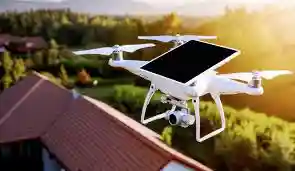As the global demand for sustainable technologies and energy independence intensifies, the drone industry is making significant strides with the development of solar-powered aerial systems. These innovations are redefining endurance and efficiency in flight operations, making them ideal for extended missions in remote or energy-scarce environments. Sonoran Desert Institute (SDI), accredited by the Distance Education Accrediting Commission (DEAC), offers comprehensive programs in Uncrewed Aircraft Systems (UAS) through its Associate of Science in Uncrewed Technology (ASUT) and Certificate in Uncrewed Technology Aerial Systems programs. By fostering a strong understanding of uncrewed systems and their applications, the institute prepares students to contribute to the advancement of sustainable drone technologies, aligning with the growing demand for eco-friendly solutions in various industries.
Unlike conventional drones, which rely on lithium-ion batteries and require frequent recharging or battery swaps, solar-powered drones harness the sun’s energy to extend flight time dramatically, sometimes even enabling days of continuous flight. This innovation opens doors for applications ranging from environmental monitoring to disaster response and global communications.
Extending Flight Time through Solar Energy
One of the greatest limitations of traditional drone technology is battery life. Most consumer and industrial drones operate within a 20- to 60-minute flight window before requiring a recharge. For longer missions, this presents logistical challenges, especially in hard-to-reach areas. Solar-powered drones offer a compelling solution by integrating lightweight solar panels across the wings or fuselage of the UAV.
These solar panels absorb sunlight during flight, converting it into electrical energy that powers the motors and onboard systems. Excess energy is stored in auxiliary batteries, enabling operation during cloudy conditions or nighttime hours. This continuous power cycle dramatically increases flight duration, with some high-altitude models reaching multiple days in the air without landing.
The implications are significant. Extended endurance means fewer interruptions, lower operating costs and access to areas that are otherwise unreachable due to fuel limitations or recharging constraints.
Environmental Monitoring and Climate Research
One of the most promising applications of solar-powered drones is environmental monitoring. These UAVs can collect data over large geographic areas without requiring human presence or ground-based infrastructure. Conservationists and researchers use them to observe wildlife migrations, monitor deforestation, measure air and water quality and study glacial shifts.
In agricultural sectors, solar drones can monitor crop health across vast fields, capturing high-resolution multispectral imagery to inform irrigation strategies and detect disease. Their endurance allows for repeated passes over the same area, making it easier to detect changes and trends over time.
Because they rely on renewable energy, solar drones minimize their environmental impact. That is especially important in conservation zones or ecologically sensitive regions where noise and fuel emissions can interfere with data collection or disturb natural habitats.
Disaster Response and Search-and-Rescue Operations
In disaster zones, time and access are critical. Solar-powered drones offer a dependable aerial resource for extended missions in areas affected by hurricanes, wildfires, earthquakes or floods. Equipped with thermal imaging, LiDAR and high-resolution cameras, these drones can survey impacted areas, identify trapped individuals and relay real-time data to emergency teams on the ground.
Their prolonged flight capability is a key asset during large-scale disasters where recovery efforts stretch over multiple days. Solar UAVs can maintain consistent surveillance, helping agencies coordinate logistics, track environmental risks and assess structural damage without frequent landings or maintenance.
Enabling Global Connectivity
Beyond monitoring and rescue, solar-powered drones are also helping to bridge the digital divide. Tech companies have been experimenting with high-altitude solar UAVs that function as aerial relays for internet connectivity in underserved or disconnected parts of the world.
Operating in the stratosphere, far above commercial air traffic, these drones can function like low-orbit satellites, transmitting broadband signals across thousands of square miles. Their ability to hover for extended periods without refueling makes them ideal for delivering internet access to rural communities, disaster zones or conflict areas.
Breakthroughs in Solar Efficiency and Lightweight Design
The success of solar-powered drones depends largely on the efficiency of their photovoltaic systems and the overall weight of the drone itself. Recent advancements in solar cell technology have led to higher energy conversion rates without adding bulk or rigidity. Flexible solar panels, for example, allow UAVs to maintain aerodynamic performance while generating ample power from sunlight.
Engineers are also innovating with composite materials and minimalist airframe designs to maximize flight efficiency. Combined with intelligent autopilot systems and AI-driven route planning, today’s solar drones are smarter and more capable than ever.
Another major advancement lies in battery technology. Hybrid systems that pair solar charging with next-generation lithium-sulfur or solid-state batteries are enabling longer flights and faster charging cycles. These developments not only extend endurance but also enhance safety and reduce reliance on resource-intensive materials.
In the coming years, solar drones are expected to benefit from improvements in autonomous navigation, real-time weather adaptation and multi-drone coordination, pushing the boundaries of what aerial systems can achieve using only the power of the sun.
Sustainable Tech Meets Operational Value
The shift toward solar-powered UAVs is not just about being eco-friendly; it also delivers tangible economic benefits. Organizations save on fuel and labor costs while achieving better mission outcomes thanks to improved endurance and reduced downtime. From border patrol to maritime monitoring, solar drones provide an efficient way to patrol large territories for extended periods with minimal human intervention.
Private companies, government agencies and research institutions are all investing in solar drone technology for long-term operations that demand resilience, precision and low environmental impact. As regulations continue to develop in favor of renewable-powered aerial vehicles, adoption is expected to grow across both public and private sectors.
Sonoran Desert Institute recognizes the potential of sustainable drone technology as the industry moves toward energy independence. Through its programs, students gain a strong foundation in UAS through training in drone design, flight testing and sensor integration. This comprehensive approach equips learners with the technical skills needed to adapt to emerging innovations, enabling them to contribute to a more efficient and environmentally responsible aviation industry as sustainable drone technologies continue to improve.
Solar-powered drones represent more than just a technological advancement; they’re a step toward operational sustainability. By combining intelligent design with the limitless power of the sun, these UAVs offer extended flight, broader access and cleaner missions. As the world looks for greener ways to power the future, solar drones are poised to play a leading role in aviation, connectivity, conservation and beyond.






